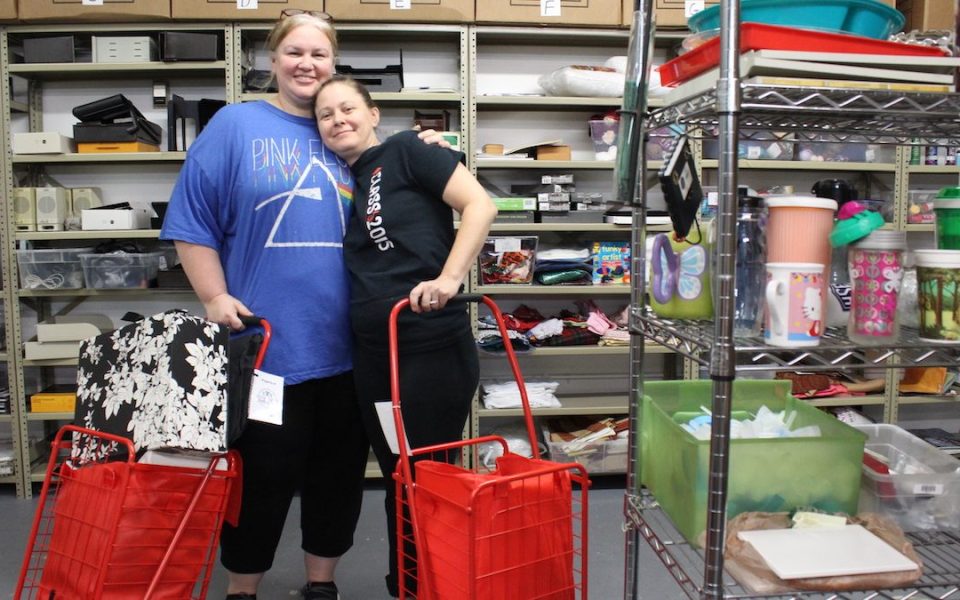A free supply warehouse and a new parking citation initiative in Greensboro helps Guilford County School teachers offset the cost of buying materials for their students and classrooms each school year.
Four-hundred seventy-nine dollars apiece. That’s how much teachers spend, on average, out of their own pockets on supplies for their classrooms, according to a national survey from 2015. But according to multiple interviews with Guilford County teachers, that number is low.
“There’s years where I’ve spent thousands of dollars,” said Jennifer Wilkins, a 9th grade civics and economics teacher at Page High School.
Her friend Christina Daughtry, an 11th and 12th grade psychology teacher at Page High School, said she spends at least $500 per year on supplies for students.
Both pushed carts filled with packs of computer paper, glue sticks, tissues, crayons and more at the teacher-supply warehouse off Pomona Road in Greensboro, in preparation for the new school year. The school supply initiative, which is a partnership between Guilford County Schools and the Guilford Education Alliance, has helped public school teachers offset costs by providing free supplies for the last 11 years.
Filled with both new and used materials, the warehouse is open to Guilford County Schools teachers and allows them to pick up supplies four times per year, with 25 spending points allotted each trip. New items in the front half of the warehouse like antibacterial hand-sanitizer, scissors, pencils, erasers and copy paper cost anywhere from 0.25 to 2 points while all of the supplies in the back portion of the building are free. Everything in the warehouse has either been donated by community members, businesses and closed schools such as the American Hebrew Academy, or has been bought by the alliance. Businesses can also set up supply drives to collect materials or donate a portion of their sales to the alliance.

“Teachers don’t make a lot,” said Karen Hornfeck, the strategic communications director for the Guilford Education Alliance. “And we want to make sure that they’re supported and that children have what they need to learn.”
Hornfeck said that the alliance believes that teachers spend closer to $900 to $1,000 each school year on supplies, and that 94 percent aren’t reimbursed for the expenses.
“It makes good economic sense for the community to support these children and these teachers,” Hornfeck said. “They’re the future workforce.”
Both Daughtry and Wilkins, who have been working as teachers for 14 and eight years respectively, said that they’ve never been reimbursed for the hundreds of dollars they spend on outfitting their classrooms each year.
“I do get paid back, but not financially,” Wilkins said. “I have a lot of relationships with students who come back to say hi and keep up in touch, and I mean it’s worth every penny.”
Teachers often pay for things they need to run their classroom like dry-erase markers but they also spend money on supplies for students who may not have all of the rudimentary tools for success, like pencils, binders and books.
And while it’s understood that paying for supplies is just part of the profession, it can be even harder on new teachers or those who have younger children of their own.
Lindsay Ragusa, a kindergarten teacher at Brightwood Elementary, said having two young sons makes it hard for her to buy additional things for her classroom.
“A lot of teachers, their kids are grown,” said Ragusa, who brought her 6-year-old son Ryan with her to the warehouse. “But some of us have younger kids, and we have to buy things for them too, so you end up not being able to buy things for your classroom.”
Cartons of crayons, Post-it notes and colorful folders filled her cart.
“I try not to ever add it up,” Ragusa said about the school expenses. “If you ever add it all up, you’d be really depressed. I throw away the receipts really fast.”
In the past Ragusa said she even started Amazon wishlists and posted them online to ask for help from the community to buy supplies for her classroom.

“What people don’t realize is these new teachers are coming in, and they’ve got to stock a classroom,” Hornfeck explained. “That’s everything from a library, a variety of games, things for if they have a rainy day, so a lot of extra things that these new teachers are having to supply.”
Last year, Hornfeck said the warehouse had more than 3,000 visits last year, from the day it opened in July through the end of August. This year, the warehouse will get additional supplies from a new city initiative that allows people to pay for parking fines with school supplies.
“Nobody likes to get a parking ticket but if we could get a little goodwill, we could do some good for teachers and students,” said Stephen Carter, the business and parking manager for the city’s transportation department. “Every year a lot of teachers have a good deal of expenses, and we’re trying to help them out.”
As of mid-August, Carter said the city has received $615 worth of school supplies that will be donated to the warehouse.
The option to pay for a parking citation with school supplies goes through the end of the month, and people have up to 30 days from the date of the citation to bring in school supplies, said Carter. He said that if the program proves successful, that the city would likely bring it back next year.
Janice Butler said the warehouse is vital to keeping her classroom running.
Butler is a teacher at Florence Elementary who works with special-needs children from the ages of 5 to 10 years old. She’s been a teacher for 13 years and has been shopping at the warehouse for the last five.
“Special needs, we don’t always get a lot of the donations,” Butler said as she shopped around the warehouse. “Like they go to the regular teachers, so I buy lots of things for my classroom.”
Butler pointed to fabric that she found in the free section of the warehouse that she plans on using to make weighted blankets to help calm kids down when they get anxious. She said she focuses on getting materials to build things she can reuse year after year.
“Some years I’ve spent probably $1,000 or more,” she said. “[The warehouse] just helps ease some of the financial burden that teachers have to deal with. People don’t realize that it takes a lot more than just pens and paper or pens and notebooks to run a classroom.”
Join the First Amendment Society, a membership that goes directly to funding TCB‘s newsroom.
We believe that reporting can save the world.
The TCB First Amendment Society recognizes the vital role of a free, unfettered press with a bundling of local experiences designed to build community, and unique engagements with our newsroom that will help you understand, and shape, local journalism’s critical role in uplifting the people in our cities.
All revenue goes directly into the newsroom as reporters’ salaries and freelance commissions.


Leave a Reply